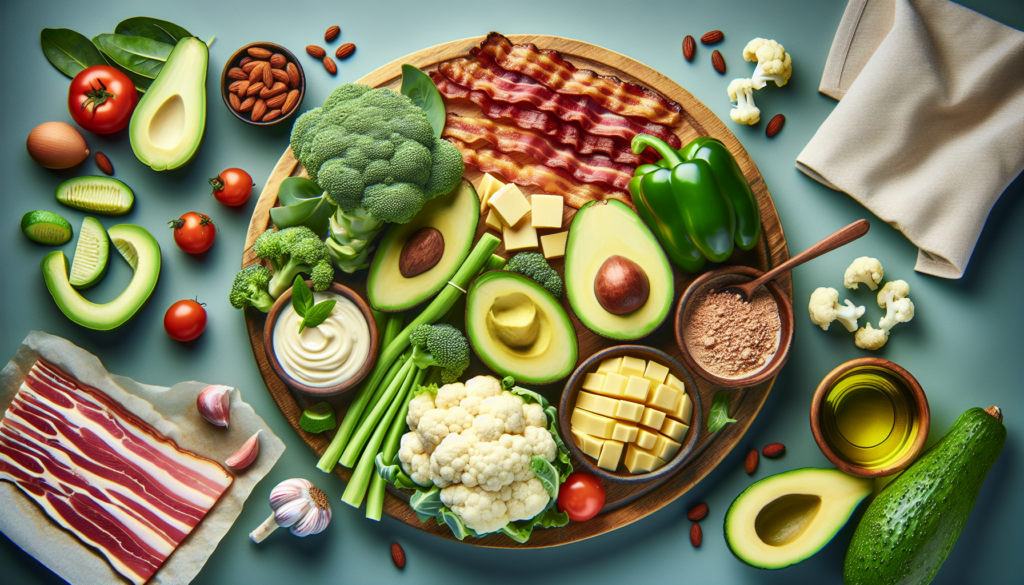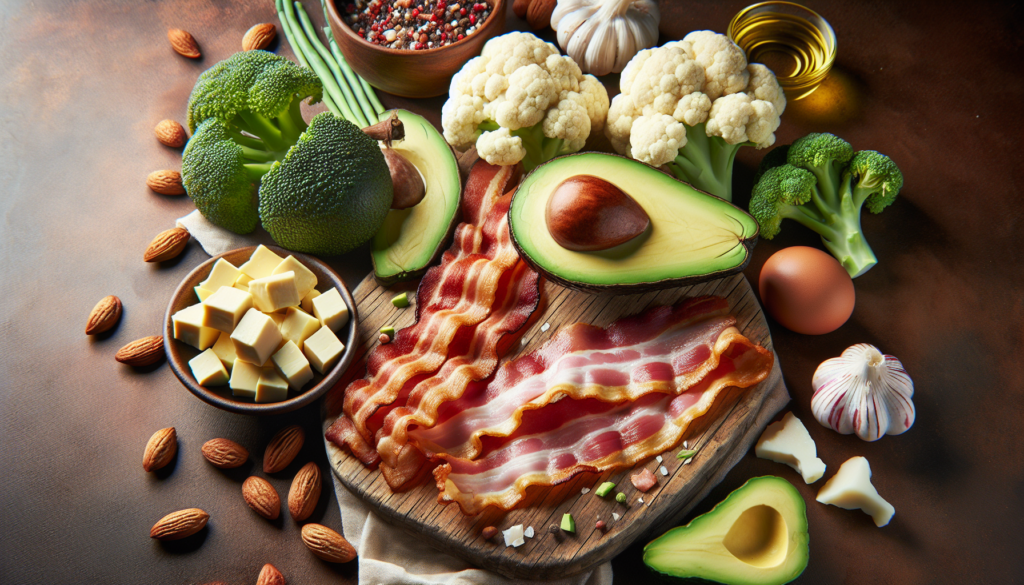Are you ready to embark on a journey towards better health and weight loss? Look no further, as this article will guide you through the ins and outs of starting the keto diet. Perhaps you’ve heard about this popular diet trend and are curious to know how it works and where to begin. Well, you’re in luck! In this article, we’ll provide you with a simple and friendly introduction to the keto diet, explaining its principles, benefits, and how to get started on your path to a healthier lifestyle. So, strap in and get ready to discover the amazing world of the keto diet!
What is the Keto Diet?
Definition of the Keto Diet
The Keto Diet, also known as the ketogenic diet, is a low-carbohydrate, high-fat diet that has gained significant popularity in recent years. It involves reducing your intake of carbohydrates and increasing the consumption of fats, which results in a metabolic state called ketosis. Ketosis occurs when your body doesn’t have enough carbohydrates to burn for energy, so it starts burning fat instead. By doing so, it produces ketones, which are used as an alternative fuel source.
Origins of the Keto Diet
The origins of the Keto Diet can be traced back to the early 1920s when it was initially developed as a therapeutic diet for treating epilepsy. Doctors noticed that fasting helped reduce seizures in epileptic patients, but it was obviously not a sustainable solution. Therefore, they devised a diet that mimicked the effects of fasting, resulting in ketosis without the need to abstain from food completely. Over the years, the Keto Diet has evolved, and its potential benefits have expanded beyond epilepsy treatment.
How Does the Keto Diet Work?
The Keto Diet works by drastically reducing your carbohydrate intake and replacing it with fats. Typically, the diet calls for consuming no more than 20-50 grams of carbs per day, promoting a significant shift in your body’s fuel source. By limiting your carbohydrates, your body enters a state of ketosis, during which it shifts from using glucose as fuel to burning fats and producing ketones instead. This metabolic shift allows your body to tap into stored fat reserves, resulting in fat loss and weight reduction.
Benefits of the Keto Diet
Weight Loss
One of the primary benefits of the Keto Diet is weight loss. When your body is in ketosis, it becomes highly efficient at burning fat for fuel. By reducing your carbohydrate intake and increasing your fat consumption, you promote fat oxidation, which can lead to significant weight loss over time. Additionally, the Keto Diet has been shown to help suppress appetite, making it easier to maintain a calorie deficit and achieve your weight loss goals.
Improved Mental Focus
Another advantage of the Keto Diet is improved mental focus and clarity. When your body is in ketosis, it produces ketones, which can cross the blood-brain barrier and provide an alternative energy source for the brain. Many individuals report experiencing increased mental clarity, improved concentration, and enhanced cognitive function while following the Keto Diet. This benefit is particularly useful for those who require high levels of mental performance, such as students or professionals.
Increased Energy Levels
The Keto Diet is known for providing a steady and consistent energy supply throughout the day. While a diet rich in carbohydrates can cause fluctuations in blood sugar levels and energy crashes, the Keto Diet helps stabilize your energy levels by relying on fats as the main energy source. Fats offer a more sustained release of energy, preventing the energy spikes and crashes associated with high-carb diets. This steady energy supply can also improve overall endurance and athletic performance.
Reduced Inflammation
Inflammation is a natural response by the body to injury or infection. However, chronic inflammation is linked to a wide range of health problems, including heart disease, diabetes, and certain types of cancer. The Keto Diet has been shown to have anti-inflammatory effects, which can help reduce the risk of chronic diseases. By eliminating inflammation-promoting foods and focusing on whole, unprocessed foods, the Keto Diet can contribute to a healthier inflammatory response in the body.

Getting Started with the Keto Diet
Consulting a Healthcare Professional
Before embarking on any diet or lifestyle change, it’s crucial to consult with a healthcare professional, especially if you have any underlying health conditions or are taking medications. Your healthcare provider can assess your individual health status and provide guidance on whether the Keto Diet is suitable for you. They can also monitor your progress and make any necessary adjustments to ensure your safety and optimal health.
Understanding Macronutrient Ratios
To follow the Keto Diet, it’s essential to understand the macronutrient ratios and make appropriate dietary adjustments. Typically, the standard ketogenic diet recommends consuming 70-75% of your calories from fat, 20-25% from protein, and only 5-10% from carbohydrates. This strict distribution ensures that your body reaches and maintains a state of ketosis. Tracking your macronutrient intake using a reliable app or tool can help you stay within the recommended ratios and achieve desired results.
Clearing Out Your Kitchen
When starting the Keto Diet, it’s helpful to clear out your kitchen of any high-carbohydrate and processed foods that may tempt you. Removing tempting sugary snacks, refined grains, and starchy foods from your pantry and refrigerator can make it easier to adhere to the Keto Diet and avoid potential setbacks. Instead, fill your kitchen with Keto-friendly foods, such as healthy fats, protein sources, low-carb vegetables, and other approved items.
Meal Planning and Prepping
Meal planning and prepping can greatly simplify your Keto Diet journey. By planning your meals in advance, you can ensure you have all the necessary ingredients on hand and avoid impulsive, unhealthy food choices. It also allows you to create a well-balanced and varied menu that meets your nutritional needs while keeping you satisfied. Prepping meals ahead of time can save you valuable time and ensure you always have Keto-friendly options readily available, especially during busy days.
Foods to Eat on the Keto Diet
Healthy Fats
Healthy fats are the cornerstone of the Keto Diet. They provide a significant portion of your daily caloric intake and are essential for reaching and maintaining ketosis. Good sources of healthy fats include avocados, olive oil, coconut oil, grass-fed butter, ghee, and fatty fish like salmon. These fats not only provide energy but also carry vital fat-soluble vitamins and promote satiety, keeping you feeling full and satisfied.
Protein Sources
Protein is another important component of the Keto Diet. It helps support muscle growth and repair, provides a feeling of satiety, and contributes to overall health. High-quality protein sources that fit well into the Keto Diet include eggs, poultry, lean meats, fish, seafood, and certain dairy products. It’s important to choose lean or moderately fatty protein sources to avoid excessive calorie intake, as the main focus of the Keto Diet is on fat consumption.
Low-Carb Vegetables
Low-carb vegetables play a crucial role in providing essential micronutrients, fiber, and antioxidants while keeping carbohydrate intake low. Non-starchy vegetables such as leafy greens, broccoli, cauliflower, zucchini, and bell peppers are excellent choices for the Keto Diet. They are low in net carbs, high in fiber, and provide a variety of vitamins and minerals. Including these vegetables in your meals can add flavor, texture, and nutritional value to your keto-friendly dishes.
Dairy Products
Dairy products can be included in the Keto Diet, but it’s important to choose options that are low in carbs and preferably full-fat. Cheese, heavy cream, and Greek yogurt are popular choices within the Keto community. However, it’s essential to be mindful of portion sizes, as some dairy products can contain hidden carbohydrates. If you have lactose intolerance or prefer to avoid dairy altogether, there are plenty of non-dairy alternatives available, such as almond milk or coconut milk.
Nuts and Seeds
Nuts and seeds can be enjoyed in moderation on the Keto Diet. They provide a good source of healthy fats, protein, and fiber, making them a satisfying and nutritious snack option. Walnuts, almonds, chia seeds, flaxseeds, and pumpkin seeds are among the nuts and seeds that are lower in carbs and fit well into the Keto Diet. However, it’s important to be mindful of portion sizes, as they can be calorie-dense, and excessive consumption may hinder weight loss efforts.

Foods to Avoid on the Keto Diet
Sugary Foods
On the Keto Diet, it’s crucial to avoid sugary foods and beverages. This includes candies, chocolates, sodas, fruit juices, and desserts made with high amounts of sugar. Consuming sugar in any form can spike your blood sugar levels, kick you out of ketosis, and hinder your progress on the diet. Instead, opt for sugar-free alternatives and natural sweeteners like stevia or erythritol, which are low in carbs and have a minimal impact on blood sugar levels.
Grains and Starches
Grains and starches are high in carbohydrates and are major sources of energy on a standard diet. However, they are not compatible with the Keto Diet due to their high carb content. Foods such as bread, rice, pasta, oats, and other cereal grains should be strictly avoided. However, there are Keto-friendly alternatives available, such as cauliflower rice, zucchini noodles, and coconut flour, which can help satisfy your cravings for traditional grain-based dishes.
Fruit
While fruit offers a variety of essential vitamins and minerals, it’s important to be mindful of their carbohydrate content while on the Keto Diet. Most fruits are relatively high in natural sugars, which can kick you out of ketosis if consumed in excess. Therefore, it’s recommended to limit fruit consumption to small portions and focus on lower-carb options such as berries. These fruits tend to have a higher fiber content and a lower sugar profile compared to other varieties.
Processed Foods
Processed foods are generally high in unhealthy fats, refined carbohydrates, and added sugars, making them unsuitable for the Keto Diet. Packaged snacks, fast food, frozen meals, and processed meats often contain hidden sugars, additives, and preservatives that can hinder ketosis and compromise overall health. Instead, focus on whole, unprocessed foods to optimize your nutrient intake and maintain ketosis.
Alcohol
Alcohol consumption can be tricky while following the Keto Diet. Most alcoholic beverages contain varying amounts of carbohydrates, which can impede ketosis and hinder weight loss progress. Additionally, alcohol affects liver function and can interfere with fat metabolism. If you choose to consume alcohol while on the Keto Diet, opt for lower-carb options such as dry wines, spirits, or light beers in moderation. However, it’s important to note that alcohol can lower inhibitions and make it more challenging to resist high-carb food temptations.
High-Sugar Beverages
Beverages such as soda, fruit juices, sweetened coffee drinks, and energy drinks are high in sugar and carbohydrates, making them unsuitable for the Keto Diet. Consuming these sugary beverages can cause blood sugar spikes and promote fat storage, hindering your ability to enter and maintain ketosis. Instead, opt for sugar-free drinks, herbal teas, or naturally flavored water to stay hydrated and avoid hidden carbs.
Managing Potential Side Effects
Keto Flu
When transitioning to the Keto Diet, some individuals may experience a collection of symptoms known as the “keto flu.” These can include fatigue, headaches, irritability, dizziness, and nausea. The keto flu is a result of your body adapting to a new fuel source and can last for a few days to a week. To alleviate these symptoms, it’s important to stay hydrated, replenish electrolytes, and ensure you’re consuming enough fats and calories to support your body during this adjustment phase.
Electrolyte Imbalances
The Keto Diet can cause electrolyte imbalances, primarily due to increased water loss and reduced intake of processed salty foods. Low levels of sodium, magnesium, and potassium can lead to symptoms such as muscle cramps, fatigue, and headaches. To maintain proper electrolyte balance, consider increasing your intake of foods rich in these minerals or supplementing with electrolyte powders or tablets. Additionally, adding a moderate amount of salt to your meals can help prevent electrolyte imbalances.
Digestive Issues
Some individuals may experience digestive issues, such as constipation or diarrhea when starting the Keto Diet. These symptoms can be attributed to the significant reduction in fiber intake from cutting out grains and increasing fat consumption. To alleviate these issues, it’s important to prioritize fiber-rich foods such as non-starchy vegetables, avocados, and nuts. Additionally, staying well-hydrated and incorporating sources of healthy fats like olive oil or MCT oil can help promote regular bowel movements.
Exercise and the Keto Diet
Benefits of Exercising on Keto
Exercising while following the Keto Diet offers several benefits. When your body is in ketosis, it becomes highly efficient at burning fat for fuel, which can enhance endurance and fat-burning during exercise. Additionally, the Keto Diet has been shown to reduce insulin levels, which can improve the body’s ability to use stored fat for energy. Regular exercise can also help support muscle maintenance and overall metabolic health, optimizing the results of the Keto Diet.
Adjusting Your Exercise Routine
When starting the Keto Diet, it’s important to make adjustments to your exercise routine to support your body’s energy needs. Initially, you may experience reduced energy levels and performance, which is a normal adaptation process. Gradually increase your activity levels, focusing on low- to moderate-intensity workouts before transitioning to more intense exercise. Be mindful of proper hydration, electrolyte replenishment, and listen to your body’s signals to avoid overexertion and potential muscle loss.
Pre- and Post-Workout Nutrition
Pre- and post-workout nutrition plays a crucial role in supporting your exercise performance and recovery on the Keto Diet. Before a workout, consider consuming a small snack containing easily digestible protein, healthy fats, and a moderate amount of carbs from low-glycemic sources. This can help provide sustained energy and enhance workout performance. Post-workout, prioritize protein consumption to support muscle repair and recovery. Options like a protein shake or a well-balanced meal containing lean protein sources can help optimize your post-exercise nutrition.
Monitoring Progress on the Keto Diet
Tracking Macros and Calories
To ensure you’re following the Keto Diet correctly and staying within the recommended macronutrient ratios, it can be beneficial to track your macros and calories. Various apps and online tools can help you keep track of your food intake and monitor your progress. By diligently recording your meals, you can ensure you’re consuming adequate fats, protein, and minimal carbs to maintain ketosis and achieve your desired health and weight loss goals.
Regular Weigh-Ins
Stepping on the scale regularly can provide you with insights into your progress on the Keto Diet. However, keep in mind that weight fluctuation is normal and can be influenced by various factors like water retention, muscle gain, or hormonal changes. Instead of solely relying on the scale, consider taking measurements, monitoring changes in body composition, and paying attention to how you feel physically and mentally. These non-scale victories can be more indicative of your progress and overall well-being.
Non-Scale Victories
The Keto Diet can bring about numerous non-scale victories that go beyond weight loss. Improved energy levels, mental clarity, better sleep, reduced cravings, and increased confidence are all positive changes often reported by individuals following the Keto Diet. Pay attention to these non-scale victories and celebrate your achievements along the way. They serve as powerful motivators and reinforce the positive impact the Keto Diet can have on your overall health and well-being.
Maintaining a Healthy Keto Lifestyle
Staying Consistent and Committed
Maintaining a healthy Keto lifestyle requires consistency and commitment. As with any dietary change, it’s essential to stay true to your goals and follow the Keto Diet as closely as possible. While occasional indulgences may be acceptable, frequent deviations from the diet can hinder progress and make it more challenging to achieve desired results. By staying consistent and committed, you give yourself the best chance to reap the benefits of the Keto Diet and reach your health and weight loss goals.
Seeking Support and Accountability
Embarking on the Keto Diet journey can be challenging at times. It’s important to seek support and accountability to stay motivated and on track. Consider joining online Keto communities, connecting with friends or family members following a similar path, or even seeking guidance from a registered dietitian or nutritionist. Having a support system in place can provide encouragement, share experiences, and offer valuable advice throughout your Keto Diet journey.
Making Sustainable Changes
The Keto Diet can be a highly effective way to promote weight loss, improve metabolic health, and enhance overall well-being. However, it’s essential to make sustainable changes that you can maintain in the long term. While the Keto Diet may initially involve strict restrictions, finding a way to incorporate a variety of nutrient-dense foods and maintaining a healthy relationship with food is crucial. Consider transitioning to a more flexible version of the Keto Diet once you’ve achieved your desired results, allowing for a balanced and sustainable approach to nutrition and lifestyle.

Hi! My name is Linda, and I’m a health and fitness specialist. I’m passionate about helping people live their healthiest and happiest lives. In my articles I share my knowledge and experience on all things health and fitness. With a passion for writing and a deep understanding of the health and fitness landscape, Linda has established herself as a trusted authority in the field.